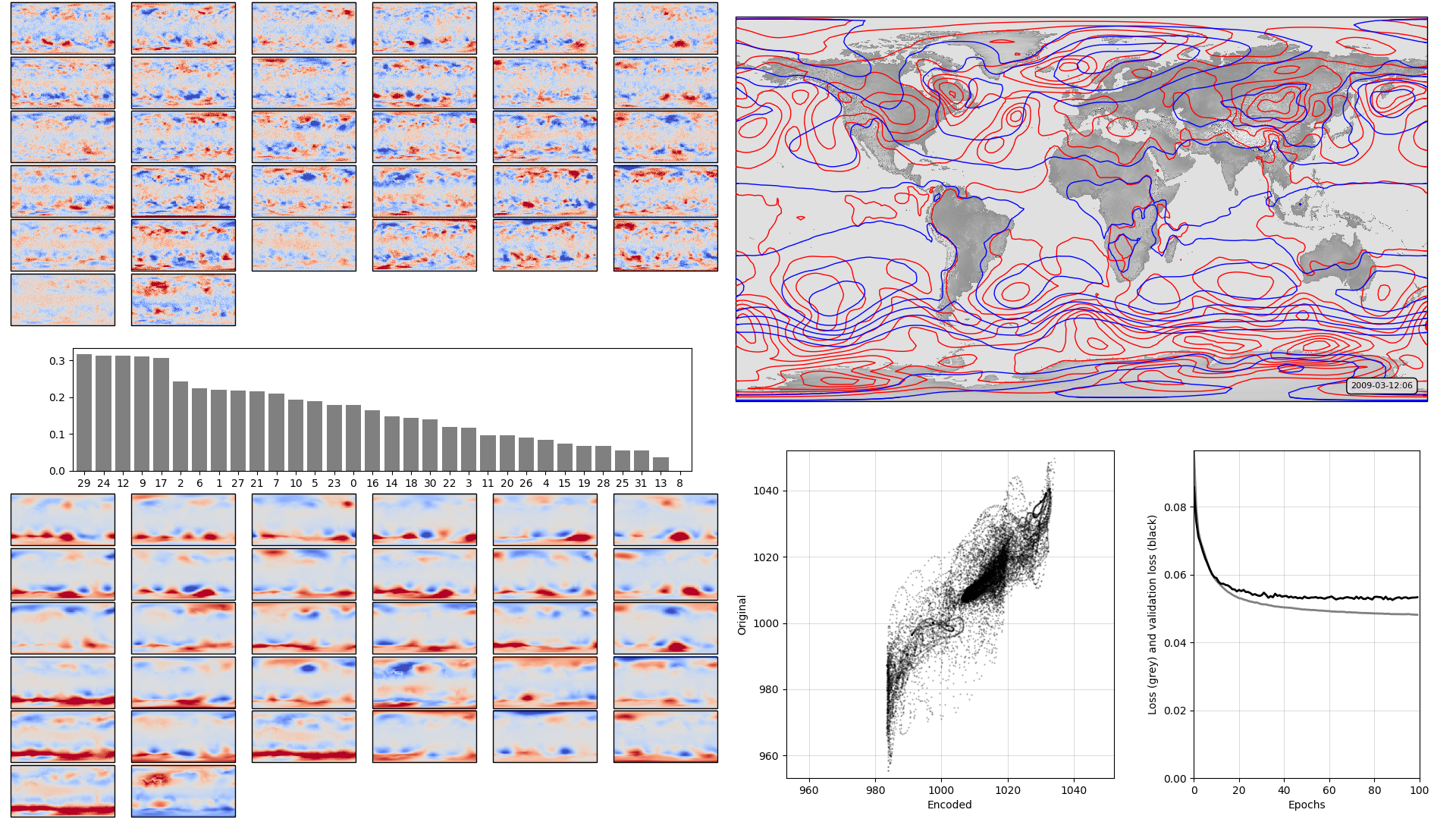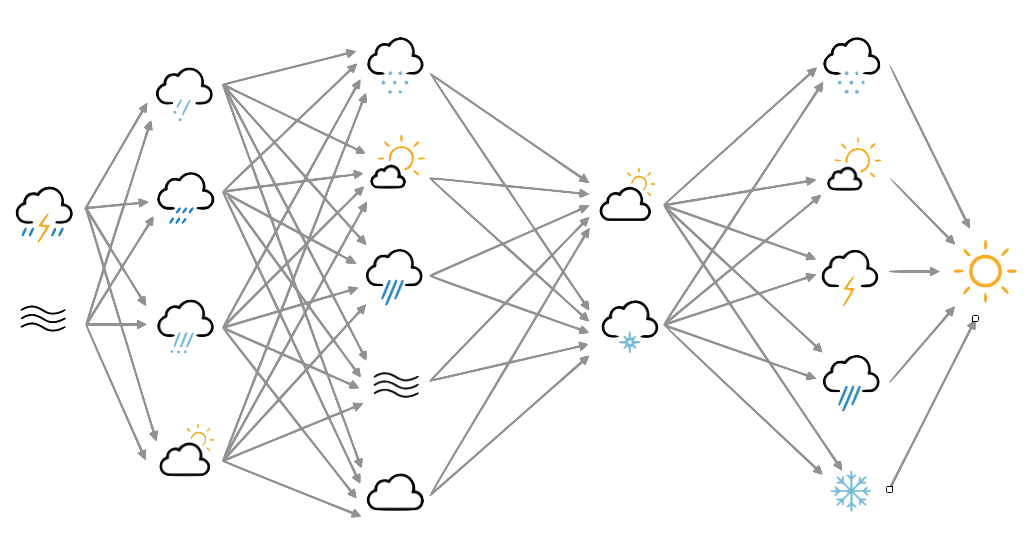Simple autoencoder validation summary¶
For a quick overview of model quality, we can combine a view of the model weights, a validation comparison, and the training rate, into a single figure.

On the left, the model weights: The boxplot in the centre shows the weights associated with each neuron in the hidden layer, arranged in order, largest to smallest. Negative weights have been converted to positive (and the sign of the associated output layer weights switched accordingly). The colourmaps on top are the weights, for each hidden layer neuron, for each input field location (so a lat:lon map). They are aranged in the same order as the hidden layer weights (so if hidden-layer neuron 3 has the largest weight, the input layer weights for neuron 3 are shown at top left). The colourmaps on the bottom are the output layer weights, arranged in the same way. Top right, a sample pressure field: Original in red, after passing through the autoencoder in blue. Bottom right, training progress: Loss v. no. of training epochs.
Script to make the figure¶
#!/usr/bin/env python
# General model quality plot
import tensorflow as tf
tf.enable_eager_execution()
import numpy
import IRData.twcr as twcr
import iris
import datetime
import argparse
import os
import math
import pickle
import Meteorographica as mg
import matplotlib
from matplotlib.backends.backend_agg import FigureCanvasAgg as FigureCanvas
from matplotlib.figure import Figure
import cartopy
import cartopy.crs as ccrs
# Get the 20CR data
ic=twcr.load('prmsl',datetime.datetime(2009,3,12,6),
version='2c')
ic=ic.extract(iris.Constraint(member=1))
# Get the autoencoder
model_save_file=("%s/Machine-Learning-experiments/"+
"simple_autoencoder/"+
"saved_models/Epoch_%04d") % (
os.getenv('SCRATCH'),100)
autoencoder=tf.keras.models.load_model(model_save_file)
# Get the order of the hidden weights - most to least important
order=numpy.argsort(numpy.abs(autoencoder.get_weights()[1]))[::-1]
# Normalisation - Pa to mean=0, sd=1 - and back
def normalise(x):
x -= 101325
x /= 3000
return x
def unnormalise(x):
x *= 3000
x += 101325
return x
fig=Figure(figsize=(19.2,10.8), # 1920x1080, HD
dpi=100,
facecolor=(0.88,0.88,0.88,1),
edgecolor=None,
linewidth=0.0,
frameon=False,
subplotpars=None,
tight_layout=None)
canvas=FigureCanvas(fig)
# Top right - map showing original and reconstructed fields
projection=ccrs.RotatedPole(pole_longitude=180.0, pole_latitude=90.0)
ax_map=fig.add_axes([0.505,0.51,0.475,0.47],projection=projection)
ax_map.set_axis_off()
extent=[-180,180,-90,90]
ax_map.set_extent(extent, crs=projection)
matplotlib.rc('image',aspect='auto')
# Run the data through the autoencoder and convert back to iris cube
pm=ic.copy()
pm.data=normalise(pm.data)
ict=tf.convert_to_tensor(pm.data, numpy.float32)
ict=tf.reshape(ict,[1,91*180]) # ????
result=autoencoder.predict_on_batch(ict)
result=tf.reshape(result,[91,180])
pm.data=unnormalise(result)
# Background, grid and land
ax_map.background_patch.set_facecolor((0.88,0.88,0.88,1))
#mg.background.add_grid(ax_map)
land_img_orig=ax_map.background_img(name='GreyT', resolution='low')
# original pressures as red contours
mg.pressure.plot(ax_map,ic,
scale=0.01,
resolution=0.25,
levels=numpy.arange(870,1050,7),
colors='red',
label=False,
linewidths=1)
# Encoded pressures as blue contours
mg.pressure.plot(ax_map,pm,
scale=0.01,
resolution=0.25,
levels=numpy.arange(870,1050,7),
colors='blue',
label=False,
linewidths=1)
mg.utils.plot_label(ax_map,
'%04d-%02d-%02d:%02d' % (2009,3,12,6),
facecolor=(0.88,0.88,0.88,0.9),
fontsize=8,
x_fraction=0.98,
y_fraction=0.03,
verticalalignment='bottom',
horizontalalignment='right')
# Add the model weights on the left
# Where on the plot to put each axes
def axes_geom(layer=0,channel=0,nchannels=36):
if layer==0:
base=[0.0,0.6,0.5,0.4]
else:
base=[0.0,0.0,0.5,0.4]
ncol=math.sqrt(nchannels)
nr=channel//ncol
nc=channel-ncol*nr
nr=ncol-1-nr # Top down
geom=[base[0]+(base[2]/ncol)*0.95*nc,
base[1]+(base[3]/ncol)*0.95*nr,
(base[2]/ncol)*0.95,
(base[3]/ncol)*0.95]
geom[0] += (0.05*base[2]/(ncol+1))*(nc+1)
geom[1] += (0.05*base[3]/(ncol+1))*(nr+1)
return geom
# Plot a single set of weights
def plot_weights(weights,layer=0,channel=0,nchannels=36,
vmin=None,vmax=None):
ax_input=fig.add_axes(axes_geom(layer=layer,
channel=channel,
nchannels=nchannels),
projection=projection)
ax_input.set_axis_off()
ax_input.set_extent(extent, crs=projection)
ax_input.background_patch.set_facecolor((0.88,0.88,0.88,1))
lats = w_in.coord('latitude').points
lons = w_in.coord('longitude').points-180
prate_img=ax_input.pcolorfast(lons, lats, w_in.data,
cmap='coolwarm',
vmin=vmin,
vmax=vmax,
)
# Plot the hidden layer weights
def plot_hidden(weights):
# Single axes - var v. time
ax=fig.add_axes([0.05,0.425,0.425,0.15])
# Axes ranges from data
ax.set_xlim(-0.6,len(weights)-0.4)
ax.set_ylim(0,numpy.max(numpy.abs(weights))*1.05)
ax.bar(x=range(len(weights)),
height=numpy.abs(weights[order]),
color='grey',
tick_label=order)
plot_hidden(autoencoder.get_weights()[1])
for layer in [0,2]:
w_l=autoencoder.get_weights()[layer]
vmin=numpy.mean(w_l)-numpy.std(w_l)*3
vmax=numpy.mean(w_l)+numpy.std(w_l)*3
count=0
for channel in order:
w_in=ic.copy()
if layer==0:
w_in.data=w_l[:,channel].reshape(ic.data.shape)
else:
w_in.data=w_l[channel,:].reshape(ic.data.shape)
w_in.data *= numpy.sign(autoencoder.get_weights()[1][channel])
plot_weights(w_in,layer=layer,channel=count,nchannels=36,
vmin=vmin,vmax=vmax)
count += 1
# Scatterplot of encoded v original
ax=fig.add_axes([0.54,0.05,0.225,0.4])
aspect=.225/.4*16/9
# Axes ranges from data
dmin=min(ic.data.min(),pm.data.min())
dmax=max(ic.data.max(),pm.data.max())
dmean=(dmin+dmax)/2
dmax=dmean+(dmax-dmean)*1.05
dmin=dmean-(dmean-dmin)*1.05
if aspect<1:
ax.set_xlim(dmin/100,dmax/100)
ax.set_ylim((dmean-(dmean-dmin)*aspect)/100,
(dmean+(dmax-dmean)*aspect)/100)
else:
ax.set_ylim(dmin/100,dmax/100)
ax.set_xlim((dmean-(dmean-dmin)*aspect)/100,
(dmean+(dmax-dmean)*aspect)/100)
ax.scatter(x=pm.data.flatten()/100,
y=ic.data.flatten()/100,
c='black',
alpha=0.25,
marker='.',
s=2)
ax.set(ylabel='Original',
xlabel='Encoded')
ax.grid(color='black',
alpha=0.2,
linestyle='-',
linewidth=0.5)
# Plot the training history
history_save_file=("%s/Machine-Learning-experiments/"+
"simple_autoencoder/"+
"saved_models/history_to_%04d.pkl") % (
os.getenv('SCRATCH'),100)
history=pickle.load( open( history_save_file, "rb" ) )
ax=fig.add_axes([0.82,0.05,0.155,0.4])
# Axes ranges from data
ax.set_xlim(0,len(history['loss']))
ax.set_ylim(0,numpy.max(numpy.concatenate((history['loss'],
history['val_loss']))))
ax.set(xlabel='Epochs',
ylabel='Loss (grey) and validation loss (black)')
ax.grid(color='black',
alpha=0.2,
linestyle='-',
linewidth=0.5)
ax.plot(range(len(history['loss'])),
history['loss'],
color='grey',
linestyle='-',
linewidth=2)
ax.plot(range(len(history['val_loss'])),
history['val_loss'],
color='black',
linestyle='-',
linewidth=2)
# Render the figure as a png
fig.savefig("comparison_full.png")
